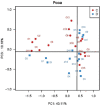Imbalance of Fecal Microbiota at Newly Diagnosed Type 1 Diabetes in Chinese Children
- PMID: 27231166
- PMCID: PMC4894039
- DOI: 10.4103/0366-6999.182841
Imbalance of Fecal Microbiota at Newly Diagnosed Type 1 Diabetes in Chinese Children
Abstract
Background: Recent studies have indicated that an imbalance of gut microbiota is associated with the development of type 1 diabetes mellitus (T1DM) and there is no literature regarding it in Chinese children yet. The aim of this study was to evaluate the alteration of gut microbiota between children with newly diagnosed T1DM and healthy controls and to determine if gut microbiota could partly explain the etiology of this disease.
Methods: A case-control study was carried out with 15 children with T1DM and 15 healthy children. The fecal bacteria composition was investigated by high-throughput sequencing of the V3-V4 region of the 16S rDNA gene and analyzed by the estimators of community richness (Chao) indexes.
Results: There was a notable lower richness of fecal bacteria in T1DM group than controls (156.53 ± 36.96 vs. 130.0 ± 32.85, P = 0.047). At the genus level, the composition of Blautia was increased in T1DM group than control group whereas the composition of Haemophilus, Lachnospira, Dialister, and Acidaminococcus was decreased. In addition, we found that the percentage of Blautia was correlated positively with HbA1c (ρ = 0.40, P = 0.031), the numbers of T1DM autoantibodies (ρ = 0.42, P = 0.023), and the titers of tyrosine phosphatase autoantibodies (IA-2) (ρ = 0.82, P = 0.000) in the study.
Conclusions: This study showed that gut microbiota was associated with the development of T1DM by affecting the autoimmunity, and the results suggested a potential therapy for T1DM via modulating the gut microbiota.
Figures






References
-
- American Diabetes Association. Standards of medical care in diabetes-2014. Diabetes Care. 2014;37(Suppl 1):S14–80. doi:10.2337/dc14-S014. - PubMed
-
- Patterson CC, Gyürüs E, Rosenbauer J, Cinek O, Neu A, Schober E, et al. Trends in childhood type 1 diabetes incidence in Europe during 1989-2008: Evidence of non-uniformity over time in rates of increase. Diabetologia. 2012;55:2142–7. doi:10.1007s00125-012-2571-8. - PubMed
-
- Patelarou E, Girvalaki C, Brokalaki H, Patelarou A, Androulaki Z, Vardavas C. Current evidence on the associations of breastfeeding, infant formula, and cow's milk introduction with type 1 diabetes mellitus: A systematic review. Nutr Rev. 2012;70:509–19. doi:10.1111/j.1753-4887.2012.00513.x. - PubMed
-
- Rodriguez-Calvo T, von Herrath MG. Enterovirus infection and type 1 diabetes: Closing in on a link? Diabetes. 2015;64:1503–5. doi:10.2337/db14-1931. - PubMed
MeSH terms
Substances
LinkOut - more resources
Full Text Sources
Other Literature Sources
Medical

